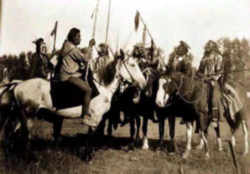


Arkansas Symbols
Arkansas Early History (Prehistory)
First Early Inhabitants of Arkansas

Early history examines the archaeological record that tells the story of the first inhabitants of Arkansas. Learn about the prehistory and culture of the first early inhabitants, and what lessons it might teach us about the early history of Arkansas.
Arkansas First Early Inhabitants Timeline
- 10,000 BC - The first indigenous people were of the Paleo-Indian culture who lived in caves or were Nomadic Hunters. The Clovis people populated the area of Arizon
- 9500 BC - Archaeologists have found evidence that people were living in the area of the Mississippi River as early as 9500 BC
- 7000 BC - Archaic Period in which people built basic shelters and made stone weapons and stone tools
- 5000 and 4000 BC - Native populations began to grow
- 2500 BC - Gulf Formational Period of the Southeast culture group with development of ceramics and pottery
- 1300 AD - Mississippian culture period of Mound builders
- 1000 AD - Woodland period with permanent houses and farmin
- 650 to 1050 AD - The Plum Bayou people continued to live at the site until around 1050 AD, when it was abandoned for unknown reasons.
- 1541 - Hernando de Soto of Spain explores Arkansas
- 1673 - Louis Jolliet and Father Jacques Marquette explore Arkansas River. They were warned of hostile tribes farther south by the Quapaw Indians and ended their explorations
Early History of Native Americans in Arkansas
The Indigenous People of Arkansas
The names of the Arkansas tribes included the Caddo, Quapaw, Tunica - Biloxi and Cherokee Indians. The Cherokee Indians were one of the "Five Civilized Tribes", because they had assimilated cultural and customs of the white settlers and colonists.
Geographically located north of Louisiana and flanked on the east by the Mississippi River's west bank, the development of the state of Arkansas spanned three centuries. Long before frontiersmen from the newly formed United States crossed the Blue Ridge Mountains and attempted settlement along the Ohio and Mississippi rivers, Spanish and French explorers came upon the native peoples living in what is now Arkansas. Archaeologists have found evidence that people were living in the area of the Mississippi River as early as 9500 BC, but native populations began to grow between 5000 and 4000 BC.
From evidence left in mounds and bluffs, including pottery and stone implements, we know that people have been living in the region that is now
Arkansas for thousands of years. The ancestors of the Indians were first to inhabit the region. The abundant wildlife and fertile soil made the area
a wonderful home for these people, who gradually developed from primitive hunter-gatherers living in caves to much more sophisticated farmers living
in large permanent villages.
One group, known as the Plum Bayou people, lived in east central Arkansas from 650 to 1050 AD They built eighteen platform burial mounds, some of
which were aligned to coincide with celestial occurrences such as the summer solstice and fall and spring equinoxes. One of these mounds is 49 feet
tall; five are still visible. The Plum Bayou people lived in permanent villages throughout the countryside. They built sturdy houses and farmed. They
also gathered wild plant foods, fished and hunted. Artifacts found at the site include simple plain-ware ceramics and stone tools. The Plum Bayou people
continued to live at the site until around 1050 AD, when it was abandoned for unknown reasons.
Tens of thousands of people were living in the area now known as Arkansas when the first Europeans arrived in the late sixteenth century.
Two prominent groups in 1541 were the Parkin people and the Nodena people. The Parkin site was occupied from 1000 to 1550. Many artifacts exist from
the Nodena site, established around 1350. However, the Nodena people and the Parkin people vanished shortly after the Spanish explorer De Soto passed
through their territories in the summer of 1541, probably because of the spread of European diseases. It is also possible that there was a drought
that had a negative impact on the native people.
The next European observers to reach Arkansas, the expedition of Marquette and Joliet in 1673, saw almost no one along the Mississippi River in northeast
Arkansas where many thousands had once lived. The first large villages they found were those of the "Akansea," thought to be the ancestors of the modern
Quapaw, who were living near the mouth of the Arkansas River.
The Tunican people of southeast Arkansas may have escaped the epidemics because of their scant population and because the Spaniards did not go far
into their territory. The Caddo people survived also, even though De Soto's army spent many months among them. What saved them, apparently, was that
they did not live in large towns where epidemics could spread quickly and easily.
As the eastern lands were settled, more Indians moved to sparsely inhabited Arkansas. The Indians who lived here included the Folsom people, Bluff Dwellers, Mound Builders, Caddos, Quapaws, Osage, Choctaw and Cherokee
We still know very little about the years from 1541 to 1850, partly because very little archeology has been done on sites occupied during those years and partly because in Arkansas the first European contacts with the Indians were unusually sporadic and poorly documented. A full 130 years elapsed between the De Soto invasion and the expedition of Marquette and Joliet. When pioneer settlement began, the state's major native groups were the southeastern Quapaws, the southwestern Caddos and the Osage, who visited the northwest to hunt.
By 1835, those groups had been forced to leave, making way for settlers of European descent and for temporary resettlement of Native Americans driven from eastern states. In the late 1830s, members of eastern tribes crossed Arkansas as part of the forced exodus known as the Trail of Tears.





